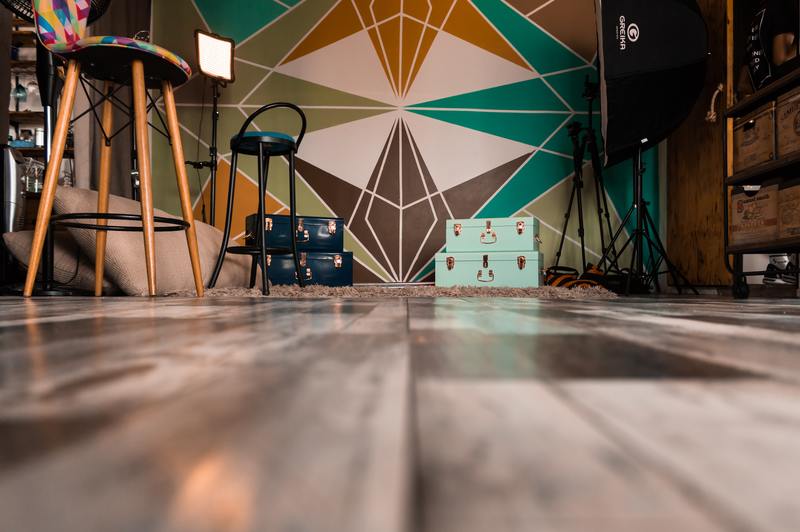Are you one of those who have been watching the aftermath of massive floods or typhoons? It all boils down to this: how to dry out water damaged floors.
When water lies on top of hardwood floors, the wood absorbs the water via its pores, producing warping and discoloration that is irreversible. If you have a flood or water-damage on your hardwood flooring, you should remove the water as soon as possible and dry your floors. Here are the best and simplified steps for your water-damaged floorings.

What happens when your floorings absorb water?
When wood is wet, it absorbs the moisture and expands, eventually cupping (or warping). When the sides of wood flooring expand and rise higher than the center of the boards, an uneven surface is created.
Keep in mind that even if the water is only topical (i.e. on top of the wood finish), it can permeate the planks and be absorbed by the plywood subfloor beneath the hardwood.
Water can also pass through engineered hardwood planks, loosening the glue beneath them and causing the flooring to spring up as they expand.
When water damage occurs, it’s critical to remove it quickly and dry the floors — not just to save the hardwood flooring (and sub-floor) but also to avoid mold growth.
Steps To Dry Out Water Damaged Wood Floorings
Step #1. Stop water source
You’ll be fighting a losing battle if water (or moisture) continues to enter the wood. So, before the floors become any worse, figure out what’s wrong and fix it.
Step #2. Put away everything
Move furniture and other such items outside in the sun, or at the very least to another room. If the goods are wet and you need to keep them inside (for example, if it’s raining or you live in an apartment), consider moving them to a waterproof floor or putting plastic between the floor and the furniture.
If your hardwood floor has carpet on top of it, remove it as soon as possible. Then, make sure to remove the tack strips, which are incredibly sharp and can injure you (or one of your children or pets) if you tread on them. Also, soaking them in water causes them to rust and turn black.
Step #3. Use a wet vacuum
You want to absorb as much water as possible as rapidly as possible. Note that a professional mitigation business specializing in water extraction and has the most fantastic equipment may be a better option.
Use the vacuum even after you’ve removed all visible water since there’s still water in the wood’s pores that you can’t see. The wet vacuum will continue to suction up water for a long time.
Step #4. Clean with a disinfectant
Keep in mind that, in addition to keeping your hardwood floors, you must also avoid mold. It would be best if you used a disinfectant that isn’t sudsy (e.g. Mr. Clean). After you’ve completed this, use the wet vacuum to remove any remaining water.
Step #5. Dehumidifier
Place a dehumidifier in the room’s center. It’s even nicer if you can obtain more than one. Make sure the water is clear every few hours (and make sure the filter is clean as well).
Make sure the dehumidifier is on for at least 24 hours. Depending on the severity of the water, you may need to use it for 2 to 3 days or even longer. It is a must to use a dehumidifier for several weeks in some circumstances.
Step #6. Use fans and air conditioning
Direct the fans to the floor. Also, open the windows about 2 inches (and keep the door open). Excess moisture will be able to evaporate, and there will be more cross ventilation.
If it’s raining or very humid outside, close the windows and only open the doors to adjacent rooms, and use a dehumidifier. Turn the fans all the way up and point them at the floor.
Step #7. Check for signs of mold and mildew
If you notice any evidence of mold or mildew, scrub the floors with a baking soda and water mixture right away. You should also find and gather the advice of a mold remediation specialist.
Step #8. Sand and refinish
You’ll probably need to sand and refinish your floors at this stage. The water frequently wears down the polyurethane, and some parts or portions of the foot may need to be replaced (just a few pieces of wood need to be woven in).
Even if some polyurethane is left on your flooring, it is likely a lot thinner and compromised. It won’t last very long, so you’re better off refinishing them now.
Conclusion
You have a good chance of salvaging the floors if you can remove the water fast and dry them correctly. The flooring can then be sanded and refinished.
After that, you can paint your hardwood in the same or a different color. Hopefully, this article on how to dry out water damaged floors will be helpful for you.
